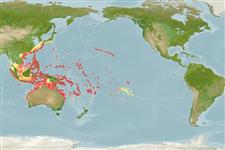Actinopterygii (ray-finned fishes) >
Perciformes (Perch-likes) >
Acanthuridae (Surgeonfishes, tangs, unicornfishes) > Nasinae
Etymology: Naso: Latin, nasus = nose (Ref. 45335).
Environment / Climate / Range
Ecology
Marine; reef-associated; depth range 0 - 90 m (Ref. 9710), usually 5 - 30 m (Ref. 37792). Tropical; 24°C - 26°C (Ref. 27115), preferred ?; 35°N - 30°S, 96°E - 127°W
Pacific Ocean: Honshu, Japan south to the Great Barrier Reef and New Caledonia and east to the Hawaiian Islands, French Polynesia, and Pitcairn. Eastern Pacific: Clipperton Island. Once regarded a wide-ranging Indo-Pacific species, the Indian Ocean population is now recognized as a separate species, Naso elegans.
Size / Weight / Age
Maturity: Lm ? range ? - ? cm
Max length : 46.0 cm SL male/unsexed; (Ref. 37792)
Dorsal
spines
(total): 6;
Dorsal
soft rays
(total): 28-31;
Anal
spines: 2;
Anal
soft rays: 29 - 31. Dorsal fin black, the black continuing as a pointed projection onto nape, with a pale blue line at base and a broad outer white zone on soft portion; anal fin mainly orange; dorsal and anal fins with a narrow blue margin and black submarginal line; caudal fin with a yellow submarginal band posteriorly (Ref. 37792). Caudal fin emarginate with adult males having trailing filaments from each corner (Ref. 37792).
Found in areas of coral, rock, or rubble of lagoon and seaward reefs, Ref. 48637. Benthopelagic (Ref. 58302). Adults usually in small groups. Juveniles in shallow rocky reefs, sometimes in small aggregations mixed with other acanthurids of similar size (Ref. 48637). Feed mainly on leafy brown algae (Sargassum and Dictyota). Sometimes in large aggregations (Ref. 37792). Very seldom poisonous (Ref. 4795). Pair-spawning has been observed.
Life cycle and mating behavior
Maturity | Reproduction | Spawning | Eggs | Fecundity | Larvae
Probably spawn in pairs (Ref. 240).
Randall, J.E., G.R. Allen and R.C. Steene, 1990. Fishes of the Great Barrier Reef and Coral Sea. University of Hawaii Press, Honolulu, Hawaii. 506 p. (Ref. 2334)
IUCN Red List Status (Ref. 115185)
CITES (Ref. 94142)
Not Evaluated
Human uses
Fisheries: minor commercial; aquarium: commercial
More information
ReferencesAquacultureAquaculture profileStrainsGeneticsAllele frequenciesHeritabilityDiseasesProcessingMass conversion
Tools
Special reports
Download XML
Internet sources
Estimates of some properties based on models
Phylogenetic diversity index (Ref.
82805): PD
50 = 0.5000 [Uniqueness, from 0.5 = low to 2.0 = high].
Bayesian length-weight: a=0.02512 (0.01384 - 0.04557), b=2.97 (2.81 - 3.13), in cm Total Length, based on LWR estimates for this species & (Sub)family-body (Ref.
93245).
Trophic Level (Ref.
69278): 2.3 ±0.19 se; Based on food items.
Resilience (Ref.
69278): Medium, minimum population doubling time 1.4 - 4.4 years (K=0.3).
Vulnerability (Ref.
59153): Low to moderate vulnerability (34 of 100) .
